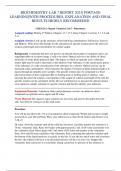Exam (elaborations)
BIOCHEMISTRY LAB 7 REPORT 2023| PORTAGE LEARNING|WITH PROCEDURES, EXPLANATION AND FINAL RESULTS.HIGHLY RECOMMEDED
- Course
- Institution
BIOCHEMISTRY LAB 7 REPORT 2023| PORTAGE LEARNING|WITH PROCEDURES, EXPLANATION AND FINAL RESULTS.HIGHLY RECOMMEDED
[Show more]



